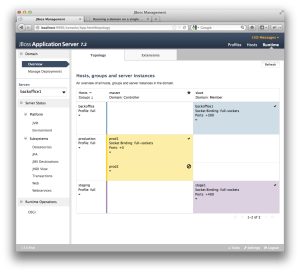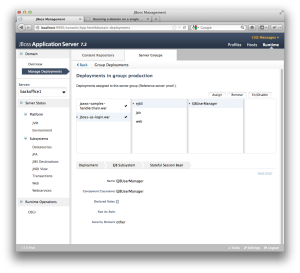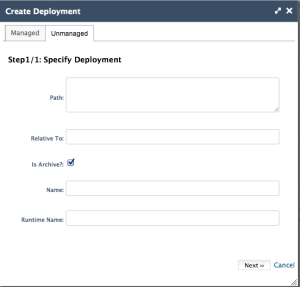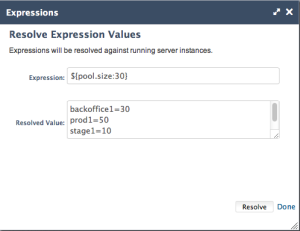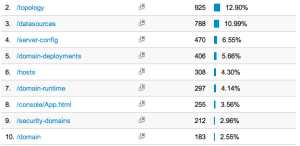Flow Control for GWT
26 Jul 2013tl;dr
Within Ajax applications you need to manage a lot of interaction and RPC related asynchronous events. The control flow structures become hard to understand and yield unpredicatable results.
We created a re-usable GWT module that provides some higher order control structures that you can use to tame the asynchronous callback beast. It’s been inspired by Async.js, but aligns with the core GWT API’s more naturally.
Control Flow API
package org.jboss.gwt.flow.client;
import com.google.gwt.core.client.Scheduler;
/**
* Flow control functions for GWT.
* Integrates with the default GWT scheduling mechanism.
*
* @author Heiko Braun
* @date 3/8/13
*/
public class Async<C>
{
/**
* Run an array of functions in series, each one running once the previous function has completed.
* If any functions in the series pass an error to its callback,
* no more functions are run and outcome for the series is immediately called with the value of the error.
*
* @param outcome
* @param functions
*/
public void series(final Outcome outcome, final Function... functions)
{
[...]
}
/**
* Runs an array of functions in series, working on a shared context.
* However, if any of the functions pass an error to the callback,
* the next function is not executed and the outcome is immediately called with the error.
*
* @param context
* @param outcome
* @param functions
*/
public void waterfall(final C context, final Outcome<C> outcome, final Function<C>... functions)
{
[...]
}
/**
* Run an array of functions in parallel, without waiting until the previous function has completed.
* If any of the functions pass an error to its callback, the outcome is immediately called with the value of the
* error.
*
* @param outcome
* @param functions
*/
public void parallel(final Outcome outcome, final Function... functions)
{
[...]
}
/**
* Repeatedly call function, while condition is met. Calls the callback when stopped, or an error occurs.
*
* @param condition
* @param outcome
* @param function
*/
public void whilst(Precondition condition, final Outcome outcome, final Function function)
{
[...]
}
}
/**
* An execution delegate able to control the outcome.
*
* @author Heiko Braun
* @date 3/8/13
*/
public interface Function<C> {
void execute(Control<C> control);
}
/**
* Execution control handle passed into functions
*
* @author Heiko Braun
* @date 3/8/13
*/
public interface Control<C> {
void proceed();
void abort();
C getContext();
}
/**
* The final outcome of the controlled flow.
*
* @author Heiko Braun
* @date 3/8/13
*/
public interface Outcome<C> {
void onFailure(C context);
void onSuccess(C context);
}
Example: Waterfall Execution
Runs an array of functions in series, working on a shared context. However, if any of the functions pass an error to the callback, the next function is not executed and the outcome is immediately called with the error.
private void runWaterfall()
{
final Function foo = new SpecificFunction("first"); (1)
final Function bar = new SpecificFunction("second"); (2)
final Outcome<StringBuffer> outcome = new Outcome<StringBuffer>() (3)
{
@Override
public void onFailure(StringBuffer sb)
{
Window.alert("Outcome is failure");
}
@Override
public void onSuccess(StringBuffer sb)
{
Window.alert("Outcome is success: " + sb);
}
};
new Async<StringBuffer>().waterfall(new StringBuffer(), outcome, foo, bar); (4)
}
Step by Step
- Create some executable command (aka Function)
- Create a command that should be run once the first one finishes
- The final callback to be invoked when the waterfall execution finishes. The StringBuffer acts as a shared context object
- Invoke the waterfall execution, providing a shared context (StringBuffer) and a number of function to be executed
Sources & Maven Coordinates
The sources for the control API can be found at github:
https://github.com/hal/core/tree/master/flow/core
The maven artefacts resides with the JBoss repositories:
<dependency>
<groupId>org.jboss.as</groupId>
<artifactId>jboss-as-console-flow</artifactId>
<version>1.6.3.Final</version>
</dependency>
GWT Module Setup
<module rename-to="your_module">
[...]
<inherits name="org.jboss.gwt.flow.Flow"/>
</module>
